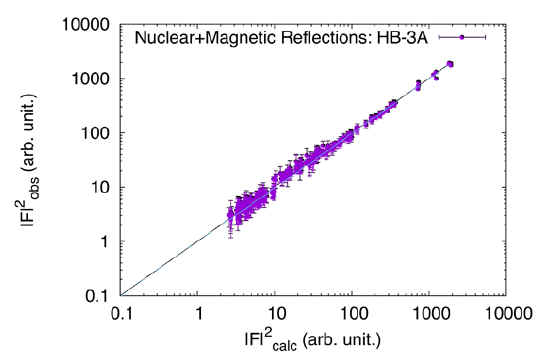Neutron Diffraction Study on Spiral and Skyrmion-lattice Phases in Multiferroic Compounds
Taku J Sato
Institute of Multidisciplinary Research for Advanced
Materials, Tohoku University,
2-1-1 Katahira, Sendai 980-8577, Japan
taku@tagen.tohoku.ac.jp
Magnetic crystals without inversion symmetry often show intriguing long-range incommensurate magnetic structures. These incommensurate structures may sometimes couple with the electric polarization, giving rise to the so-called multiferroic behaviour. In this talk, I would like to introduce our recent two neutron diffraction experiments on incommensurate magnets.
The first system is MnSb2O6, which belongs to the space group of P321 [1,2]. Combining unpolarized and polarized neutron diffraction, we determined the magnetic structure of the ordered phase established below TN = 11.6 K (Fig. 1). The magnetic modulation vector was found to be q ~ (0, 0, 0.182). The spin structure is dominantly spiral with the spin-rotation plane slightly tilted from the [210]-c plane towards the [010] direction. As the magnetic order establishes at TN, electric polarization P becomes finite, indicating multiferroic nature of this compound. Furthermore, due to the tilting of the spiral structure, this compound shows very interesting switching behaviour of the electric polarization when the external field is rotated in the ac-plane. The switching was observed at very low magnetic field, such as H = 0.6 T, indicating that this switching behaviour is closely related to the switching between the two differently tilted magnetic structures. In the talk, we will report details of the magnetic structure analysis on this compound.
Figure 1. |F|2obs vs |F|2calc for the tilted cycloidal spin structure proposed for MnSb2O6. Unpolarized neutron intensities are shown in the figure.
The second system we will report is Cu2OSeO3, which belongs to P213. At zero external magnetic field, this compound shows incommensurate helical magnetic order below Tc ~ 58 K. Recent small angle neutron scattering (SANS) study shows that under weak magnetic field of H ~ 200 Oe, a skyrmion-lattice phase was stabilized at a narrow temperature range just below Tc [3]. Using the SANS technique, we investigated response of the skyrmion-lattice phase to the external electric field. In contrast to the weak rotation of the skyrmion-lattice under external electric field reported earlier [4], we observed complete switching of the two skyrmion-lattice phases with gigantic rotation angle of 30 degrees under the moderate electric field of E = 3 kV along the [001] direction. The time-dependence measurement shows that such switching requires quite long time (in a time scale of an hour), compared to the formation of the skyrmion-lattice phase itself under zero electric field. In the talk, we will report details of the time dependence of the skyrmion-lattice dynamics.


Figure 2. SANS patterns observed at T = 54.1 K and H = 160 Oe. (Left) SANS pattern observed immediately after applying E = 3 kV along [001]; (Right) SANS pattern observed 4500 sec after applying E. Complete switching (i.e. 30 degree rotation) of skyrmion-lattices was confirmed after one hour of soaking time. Dark regions in p/4, 3p/4, 5p/4, 7p/4 are due to missing detectors.
1. J. N. Reimers and J. E. Greedan, J. Solid State Chem. 79 (1989) 263.
2. R. D. Johnson, K. Cao, L. C. Chapon, F. Fabrizi, N. Perks, P. Manuel, J. J. Yang, Y. S. Oh, S. –W. Cheong, and P. G. Radaelli, Phys. Rev. Lett. 111 (2013) 017202.
3. S. Seki, J. –H. Kim, D. S. Inosov, R. Georgii, B. Keimer, S. Ishiwata, and Y. Tokura, Phys. Rev. B 85 (2012) 220406(R).
4. J. S. White, K. Prsa, P. Huang, A. A. Omrani, I. Zivkovic, M. Barkowiak, H. Berger, A. Magrez, J. L. Gavilano, G. Nagy, J. Zang, and H. M. Ronnow, Phys. Rev. Lett. 113 (2014) 107203.
This work has been performed in collaboration with Y. Nambu, D. Okuyama, D. Higashi, T. Hong, M. Matsuda, H. Cao, K. Ohishi, S. Takata, J. Suzuki, M. Kinoshita, S. Seki, S. Ishiwata, and Y. Tokura.
